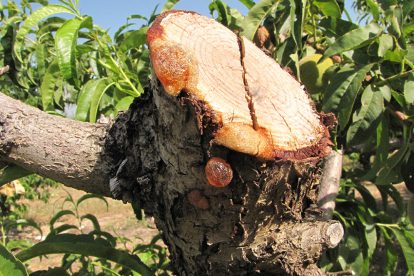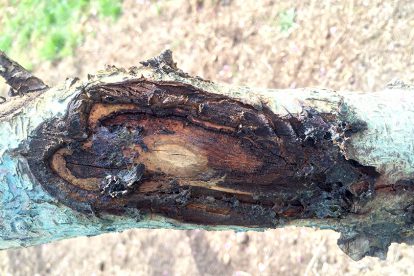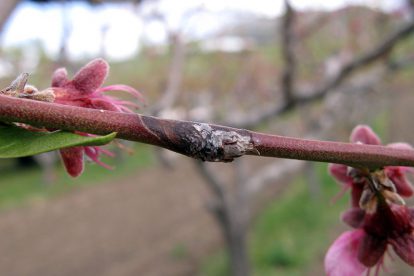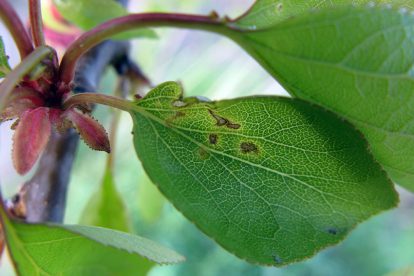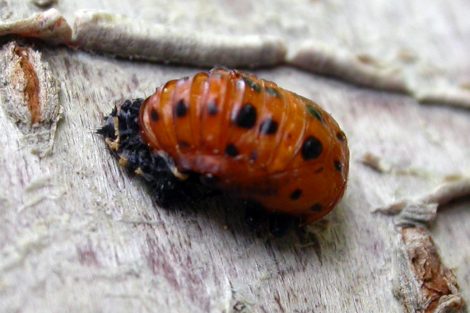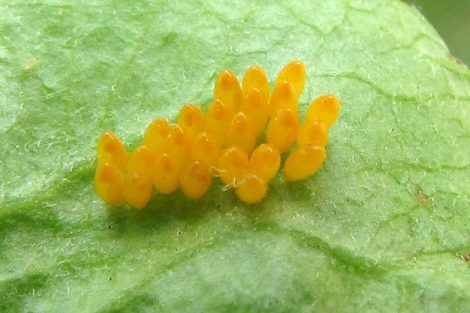In this Issue:
- Apple, Pear: powdery mildew, fire blight, and codling moth
- Peach/Nectarine, Apricot, Plum: gummosis (cytospora canker), coryneum blight, nectarine scarring, and peach twig borer (for commercial growers)
- Beneficial Spotlight: lady beetles
- Guide to Protecting Pollinators
APPLE, PEAR
Apple Powdery Mildew

apply fungicide at open cluster stage
Apple powdery mildew overwinters on twigs, and as a result, new infections can occur very early in the season. Depending on weather conditions, the pathogen can become active at about the tight cluster stage. If left untreated, new infections can occur all summer long, just from humidity within the tree canopy.
Treatment timing for the first fungicide application for powdery mildew is before bloom, when the leaves open, called “open cluster” stage.

If your apples have had powdery mildew in the past, consider treating at this time. A second application should be made at petal fall.
Cortland, Idared, Gingergold, Braeburn, Gala, and Jonagold are all varieties that are more susceptible.
Commercial growers: treatment options are shown by clicking here.
Residential growers can use:
- Spectracide Immunox: separate applications by at least 14 days and apply as needed
- Sulfur (organic; many brands): apply every 10 days as needed
- Neem oil or 1% horticultural oil (organic; many brands): apply every 3 to 5 days as needed, but not when temperatures will reach 85 F within 4 hours of application
- Potassium bicarbonate (organic; Monterey Bi-Carb, Garden-Ville): apply every 7 days as needed
Fire Blight
infections may happen on blossoms in warm, wet weather
During apple and pear bloom, fire blight infections are a risk when conditions are warm and wet. For most areas of northern Utah, in particular along the Wasatch Front, the risk of fire blight is HIGH to EXTREME through April 23.
But remember that open blossoms are required for infection. In addition, moisture is required, and rain is predicted in some areas for this Sunday, April 20.
So if you have trees or orchards that have been affected by fire blight in the past or are sensitive, consider an antibiotic application on Saturday, with a re-application on Tuesday, if there are flowers.
You can watch fire blight predictions on Utah TRAPs by selecting a location closest to you, and then selecting “fire blight” under the Pest drop down menu.
- For commercial producers, most areas (except the southern part of Utah County, which has resistance) can use streptomycin. Where resistance occurs, producers should use oxytetracycline (MycoShield) or Kasumin. One application can be a mix of oxytetracycline and streptomycin.
- Most diligent backyard growers should not need to apply an antibiotic. (Although if necessary, most garden centers carry streptomycin.) Instead, monitor trees closely starting two weeks after full bloom (which is when infections start to become visible). Prune out new infections immediately (on a dry day).
Codling Moth

no action to take now in northern Utah
To determine the codling moth spray dates, we hang monitoring traps in northern Utah orchards. Once those traps catch moths, we can then run the calculations to determine the dates. As of now, we have not caught any moths yet (in northern Utah). However, warmer weather is coming in the next two weeks, and we will provide the information as soon as we know. Based on information from the past, the starting time will be close to May 20 for the warmest areas of northern Utah.
It is good to know which insecticides will work, whether you choose to be organic or conventional.
Options for Commercial Growers are found on the Intermountain Tree Fruit Production Guide website.
Options for Residential Trees
Note that when spraying a pesticide, it is important to know how long the material will last. For any product you are using, check the “active ingredients” on the front label of your product (in small print on the lower right or left of the label). Sometimes there are several ingredients, sometimes, just one. Some materials last longer than others, and the time between sprays is not always listed on the label.
| Product Name | Efficacy | Residual Length (days) | Comments |
|---|---|---|---|
| CONVENTIONAL | |||
| Spectracide Triazicide (gamma-cyhalothrin) | Good to Excellent | 14-17 | wait 21 days to harvest |
| Monterey Bug Buster 11 (esfenvalerate) | Good to Excellent | 14-17 | wait 21 days to harvest |
| Bonide Fruit Tree & Plant Guard (lambda-cyhalothrin) | Good to Excellent | 14-17 | wait 21 days to harvest |
| Bonide Malathion; Hi Yield Malathion | Good | 5-7 | max 2 applications; some products are pears only |
| GardenTech Sevin (zeta-cypermethrin) | Good to Excellent | 14-17 | wait 14 days to harvest |
| ORGANIC | |||
| AzaSol, EcoGarden (azadirachtin) | Good | 7-10 | purchase online |
| Cyd-X (codling moth virus) | Good (if populations are low) | 7 | works best when used at beginning of generation; expensive and purchase online |
| oil such as All Seasons Oil, EcoSmart, Neem oil | Good on eggs only | 3 | recommended for first application of the generation only |
| Ortho Fruit Spray; Fertilome Fruit Tree Spray; Safer End All; Bonide Orchard Spray (all contain pyrethrin) | Good | 3-5 | |
| Monterey / Fertilome Spinosad; Captain Jack's Deadbug Brew; Natural Guard (all contain spinosad) | Good | 10 | max 6 applications per season; if applying to peach or cherry, can re-apply after 7 days |
PEACH/NECTARINE, APRICOT, PLUM
Gummosis

prune out infected branches
Gumming on stone fruits (peach, apricot, plum) is very common, and most evident in spring as the sap starts to flow. The oozing of gum is generically referred to as gummosis and it can be clear or dark amber in color. By the end of the summer, it will have become almost rock-hard.
The most common cause of gumming on stone fruits is a disease called cytospora canker. It is caused by a fungus (Cytospora) that infects bark through an existing wound such as pruning cuts, sunscald injury, cold injury, hail, deer rubs, etc. The pathogen kills the bark and underlying wood, and the tree oozes gum at the infection site as a defensive measure.
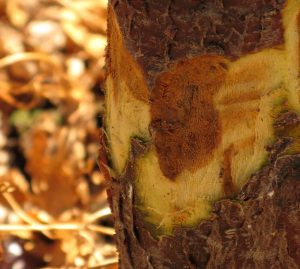
Gumming from cytospora is dark amber in color, and if you scrape the bark off, the dead phloem will appear cinnamon brown in color. Cytospora canker is very common in Utah’s peach and apricot orchards, as well as on backyard trees.
Prevention is the key to managing Cytospora
- In normal pruning operations, make proper cuts (i.e., do not leave stubs or do not make “flat cuts” that remove the branch collar where healing would normally occur) and do not prune in wet weather. Pruning the Orchard
- Protect the bark during winter from sunscald. Either apply white tree wrap from December to March, or paint the trunk (anytime) with 50/50 latex paint/water;
- Prune out infected limbs and twigs back to healthy wood, and sterilize tools with 10% bleach or Lysol wipes between cuts. Sometimes it is not possible to remove all infected limbs. In that case, be diligent about tree health, sanitation, and regular pruning practices.
- Remove severely affected trees from the orchard or backyard.
- Keep trees healthy with optimal watering, mulching, nutrition, etc.
- An excellent bulletin on Preventive Control of Cytospora Canker is available from Colorado State University.
Other Causes of Gumming
- Thick gumming at the base of the tree (no higher than 8-12”): Greater peachtree borer. Trees can be protected with a properly timed insecticide, typically in late June (we will include dates in a future advisory).
- Small areas of ooze, throughout the tree: Borers. Flatheaded or shothole borers will only attack weakened trees or wounds such as where sunscald has occurred. Usually there is very little ooze associated with these insects because the trees are already weakened. If the borers attack healthy trees, however, the tree will exude copious sap/ooze to flush out the larvae. This ooze is often clear in color, and limited to beetle entry holes. Management of these pests is difficult, and may include bark sprays of permethrin May through August.
- Random pattern of gumming: Wounds or other cause. Gummosis not caused by a pathogen will run somewhat clear in color (but will dry to amber). Wounds include frost cracks or sun scald, bark injury, cat scratching, hail, etc. Other causes include planting too deep, excessive irrigation, severe summer pruning, or over-bearing.
If you are not sure that a pathogen is causing the gummosis, scrape the outer bark away. If the inner bark is still cream-colored (healthy), the oozing is caused by a non-living factor, and there is nothing you should do. If the wood is tan to brown, it is dead, and was most likely killed by a pathogen.

Coryneum Blight (Shothole)
apricot, peach – fungicide application at shuck split stage
The main symptom of coryneum blight (shothole) that concerns growers is damage to the fruit skin in the form of purple spotting, scabs, or sunken lesions.
If coryneum blight is a problem on your peach, nectarine, or apricot trees, note that one of the most important times to apply a fungicide is after bloom, at the shuck split stage (see image above).
This pathogen is spread primarily by rain, and optimal conditions for infection are when temperatures are from 70 to 80°F.
Commercial growers can find options by clicking here.
Backyard growers can use one of the following:
- Spectracide Immunox
- product containing chlorothalonil (Daconil, for example. Note that chlorothalonil cannot be used after shuck split while fruit is still on the tree.)
- Captan
Nectarine and Plum Scarring (Western Flower Thrips)

application of spinosad at petal fall in evening
Thrips are tiny insects whose feeding can result in deformed nectarine and plum fruits. Thrips feed on the developing fruit from bloom time to petal fall. As the fruit matures, scars form from the feeding wounds, and oozing gum may be associated with the scars.
To prevent thrips injury, spray spinosad (many brands; organic) at or right after bloom. Treat at night or early in the morning because spinosad is harmful to bees when the product is wet (the dry product does not affect bees). Just one application with thorough coverage is needed.
Peach Twig Borer – Commercial Producers
Mating Disruption
For application of the Isomate PTB dispensers, they can be hung at any time now. The manufacturer recommends hanging them up to a month before expected moth flight to ensure complete saturation of the orchard.
Pink to Petal-Fall Application
Before shoots have started to elongate, and while larvae are exposed, trees can be sprayed to help reduce the population. Data out of University of California-Davis showed that one or two bloom-time treatments of the organic insecticide, Bt (Bacillus thuringiensis), is as effective as a dormant oil+insecticide spray. (If you already sprayed a dormant oil for PTB, you do not need to apply the Bt spray.)
Options registered in Utah include Biobit, Dipel, and XenTari.
Bt is a bacterium that must be consumed by the insect to be effective. The material only lasts about 3-5 days, which is why a second treatment may need to be applied. Although Bt does not affect pollinators or other beneficial insects, it should be sprayed at night so as not to disrupt them.
Bt products can be stored for 2-3 years in a cool, dry location. Liquid formulations will not last quite as long. Once the concentrate is mixed with water, it should be used within 12 hours.
OTHER INFORMATION
Beneficial Spotlight – Lady Beetles
Aphid activity on fruit trees is starting now, and one important aphid predator that most people know about are lady beetles. This beneficial insect is among the first to be seen in spring as it is active in cooler weather, including late fall.
Lady beetles also feed on mites, scale crawlers, and mealybugs. Adults can consume 100 aphids per day, and when prey is scarce, they survive on pollen, nectar, or insect honeydew. The larvae are just as voracious.
The most common lady beetle species we encounter today is actually not native. The multicolored Asian lady beetle has become quite competitive against our native species, and in some parts of the country, it is a nuisance home invader.
Protecting Pollinators
 Cornell University offers a publication on protecting pollinators: Pesticide Decision-Making Guide to Protect Pollinators in Tree Fruit Orchards.
Cornell University offers a publication on protecting pollinators: Pesticide Decision-Making Guide to Protect Pollinators in Tree Fruit Orchards.



